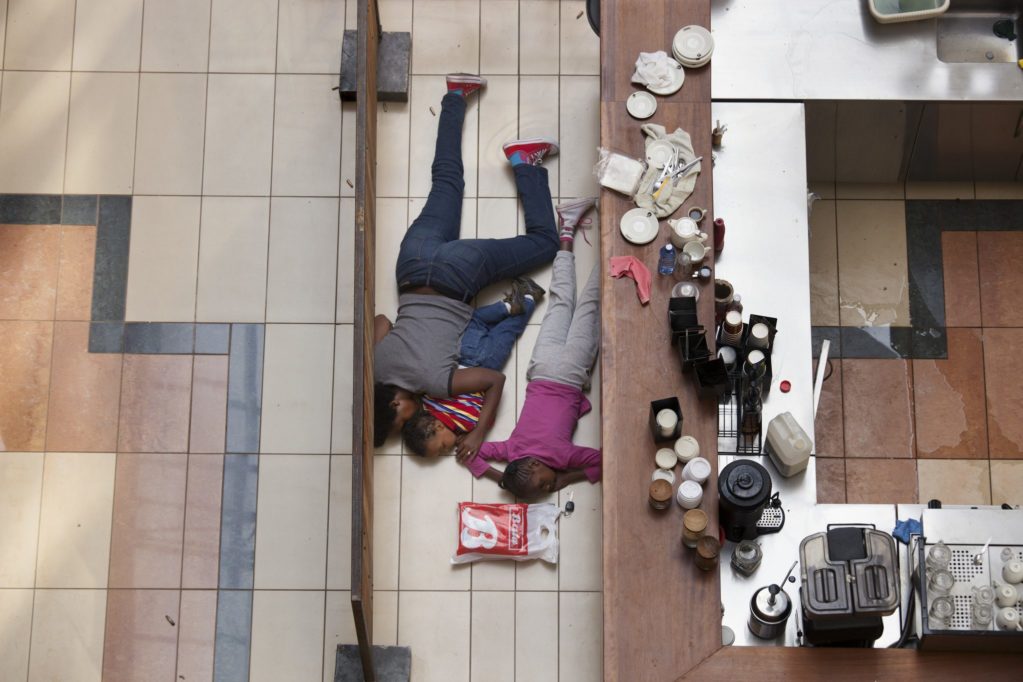It’s a haunting image. A terrified woman lies flat on the floor of a coffee shop where she might have been sipping a cappuccino just minutes before. Beside her are her two young children. The woman clings to her son and clutches her daughter by the elbow. Empty bullet casings are scattered around them. But what really makes the picture so powerful is how it depicts a safe and familiar scene as anything but. This is a split second in the life of a mother fighting for her children.

Kenya Defence Forces soldiers comb the rooftop of the Westgate shopping mall, on the fourth day since militants stormed into the mall, in Nairobi September 24, 2013. Somalia’s al Shabaab Islamist group said on Tuesday its militants were still holed up in a Kenyan shopping mall they attacked at the weekend and there were “countless dead bodies”, raising fears the death toll could be higher than 62. REUTERS/Noor Khamis (KENYA – Tags: CIVIL UNREST CRIME LAW MILITARY) – RTX13XVR
Nairobi-based photojournalist Tyler Hicks, of The New York Times, took the photograph and, in May, won a Pulitzer Prize for it. A month after it was taken, the woman in the picture contacted him. They found themselves talking about the mall music.
“In covering conflict, it often isn’t the big things that you remember. It’s not the loud explosions or gunfire that your mind focuses on but often it’s some small detail,” he says on a call from Iraq.
“With all the shooting and running around and people screaming there was this very calm music echoing through the shopping mall.”
The woman told him she spent almost five hours lying in that very place with her children, trying to keep them calm and quiet. She remembers quietly singing along with that same mall music to her children to try to distract them and keep them still.
Hicks has risked his life many times to take the photos that have defined his career but this one sticks with him.
“That picture for me sums up what happened there, this is an attack on innocent civilians. The fear on her face and this amazing scene of her trying to hide and protect her kids,” he says.
Since the mall siege a year ago, Nairobi has been under persistent attack. A few months after Westgate, a hand grenade was thrown on to a minibus in the city suburb of Eastleigh. It claimed four lives and maimed at least 40 others. A day earlier, twin bomb blasts rocked the northern town of Wajir, killing one and injuring three others.
But perhaps some of the biggest attacks since Westgate were carried out more recently, further away, on the Kenyan coast. In July, unknown gunmen opened fire at marketplaces in the coastal villages of Hindi and Gamba. As with the mall attack, the gunmen began shooting at market goers indiscriminately. Both attacks claimed 29 lives. Earlier, in June, gun battles raged in Lamu, a resort town, and a number of buildings were set alight. That attack killed 48.
The Somali extremist group, Al-Shabaab, has taken responsibility for each of those attacks. After Kenyan armed forces, supporting a weak UN-backed Somali force, began pursuing the Al Qaeda-linked militants in southern Somalia three years ago, the group has vowed to fight back.
“Kenya’s operations in Somalia are something of a black box,” says Parselelo Kantai, East Africa Editor for The Africa Report, who’s been following the region’s insecurity.
“Because no independent reports have revealed what is going on, Al-Shabaab’s claims of atrocities being committed there by the KDF [Kenya Defense Forces] cannot be ignored… that’s the reason Al-Shabaab have given for attacking Kenya.”
In May, the group officially announced their war against Kenya.
Beyond the human cost, Hicks’ image of the woman and children tells another story. The abandoned coffee shop, where the family spent hours hiding, is still abandoned today. The economic cost to business owners within the mall was catastrophic. Many lost everything because they did not have the right insurance policy. Even the mall’s owners lost out, despite their insurance pay outs. Until the mall reopens, its owners will lose around $4.5 million every year.
Also, scores of mall employees lost their jobs because of the attack. The mall’s grocery store, Nakumatt, lost three employees during the shootings and its 150-strong staff was made redundant. A new store in another part of the city may rehire some of them.
It has been a year since Westgate and the aftermath is a difficult reality for its survivors. Life for many in Kenya will never be the same again. But if you look closer at the Hicks photograph with the terrified family on the cafe floor, you’ll see that some hope still lingers.
